The final stage of the ceiling repair is the installation of lighting. Proper design will make the interior complete, visually increase the space, create a mood, atmosphere. Using LED lamps, you can even delimit zones without cluttering your home with walls and doors.
The development of LED lighting has gradually replaced other light sources with affordable cost, a variety of choices. Characteristics of LED lamps: long life (up to 100 thousand hours), environmental friendliness, economical consumption of electricity, safe use and disposal.
LED lamps are used in various areas: in lighting huge industrial areas, small offices and even in street lamps.
Variety of choices
The classification of lamps is based on the type of light emitted and the design. There are three types:
- Lighting general purpose. Such lamps emit a light that is pleasing to the eye, reminiscent of daylight. Are established in office, premises;
- Directional lighting. Such lamps are used in antique, exhibition or trade showcases or to create a light accent in the interior of the room;
- Linear lighting. Such lamps are an elongated tube equipped with a swivel base. The special design allows you to change the angle of light scattering. Most often used in offices.
Also, LED lamps differ in the type of base. Edison base, pin, bulb lamps are often found. Less often - a pin, soffit, focusing base, and with a "hidden" contact.
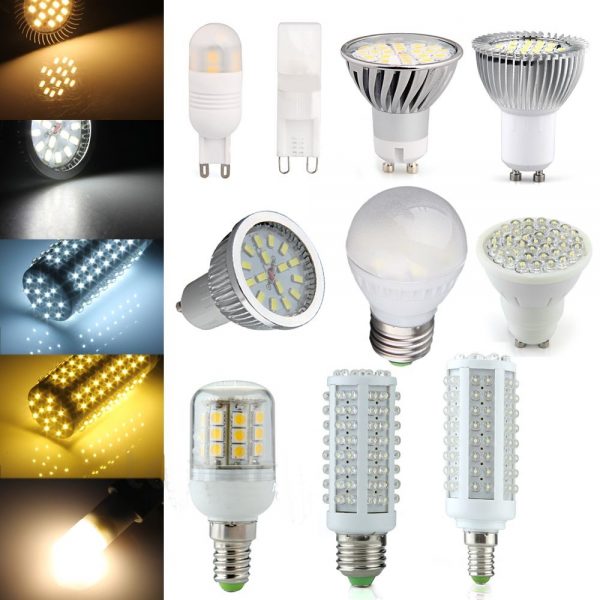 Types of LED lamps
Types of LED lamps Where to start installation?
Before proceeding with the choice of model, the number and required power of fixtures are calculated. The last criterion is influenced by the color design of the interior, furniture, room area, individual preferences. Someone loves a warm, non-dazzling light, while someone prefers brightness, saturation luminous flux.
It is not always advisable to use recessed fixtures. The result will improve if you additionally mount table or wall lamps. Calculated power ceiling lamps while decreasing.
If you are not going to give up local action lamps, then ceiling-mounted lamps can be organically replaced led strip. In the matter of lighting design, there is enough room for imagination.
Not without a diagram
If you decide to install lamps with your own hands, without electrical circuit you can't do it. Start development only when you have decided on the type of lamps, the number of points and fixtures, and have made an estimated power calculation.
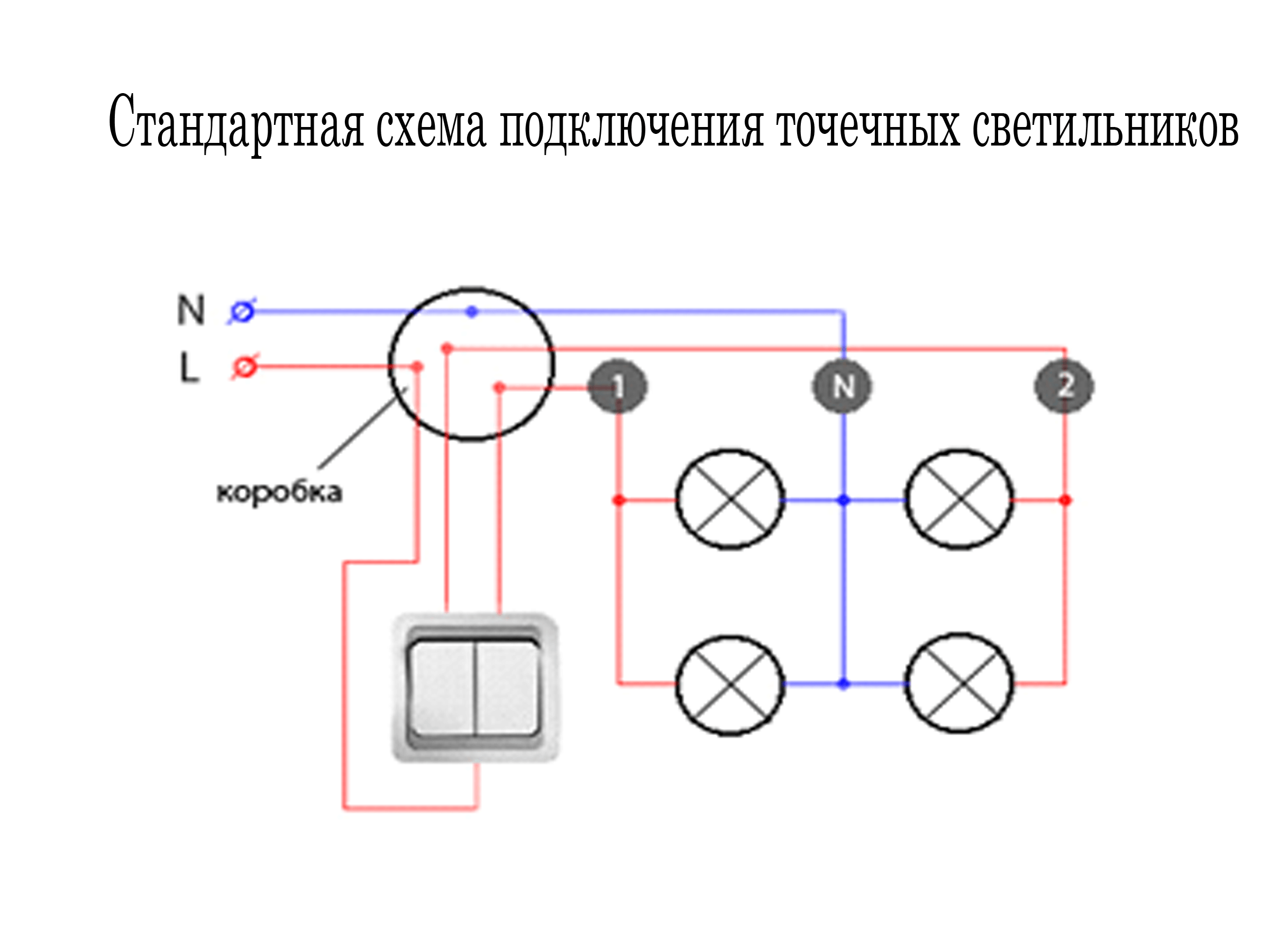 Standard scheme connections
Standard scheme connections When choosing a place where you install the lamp, consider the presence of a computer or TV in the room. This is due to the reflection of the incident beam. Therefore, when choosing lighting mounting points, think over the layout of the room in advance: where the furniture will stand, the TV, the mirror will hang, etc.
Suspended ceiling
In the design of various premises (waiting rooms, restaurants, shops, warehouses, offices, etc.), suspended ceilings are used. They are practical, hide flaws, require almost no maintenance. Big choice design solutions and a variety of lighting design also incline consumers to choose these ceilings. In addition, you can sheathe the ceiling with drywall with your own hands, without the help of professionals.
More often with suspended ceilings, the following types of lamps are used:
- raster;
- point.
The former differ in the type of installation (overhead, built-in) and screened lattice. As a screen, a white lattice, parabolic or with an opal diffuser, is used.
LED lighting in the ceiling
Suspended ceiling is easy to install and easy to equip with fixtures different forms and sizes. Lighting will emphasize the splendor of a multi-level design. Using different types lamps, the space is divided into zones.
Of course, everyone wants to enjoy the beauty of the ceiling as long as possible. To increase the service life of lamps of this type and protect against voltage instability, you can use transformers.
Luminaires are mounted in the structure itself. To do this, holes are made in the slabs, so it is important to correctly calculate the size of the space between the ceiling and the plasterboard sheathing. Usually for halogen elements, the ceiling is lowered by 100 mm. For incandescent lamps, space is required less, about 5 cm.
All cables are routed prior to installation of the false ceiling.
 We fix the lamp in the false ceiling
We fix the lamp in the false ceiling What is required for installation?
If you decide to refuse the services of professionals, and create lighting with your own hands, you will need:
- lamps;
- Spotlights;
- power wire;
- electrical tape and heat shrink with insulating properties;
- terminal blocks or sleeves;
- switches.
When choosing lamps, consider the light spectrum of the elements and the light power. Drywall is refractory, so it is best to choose a regular wire with two or three cores (VVG-2 (3) x1.5). It is convenient to connect the wires with terminal blocks, but it is more reliable to use sleeves, copper-tinned or copper, for this purpose. There is also a bolted connection. To avoid charring or heating, this connection should be checked at least 2 times a year.
Connection points are isolated. To do this, use ordinary electrical tape or heat shrink tubing.
The installation process for convenience is divided into five steps:
- layout;
- laying electrical wiring;
- drilling holes;
- connection;
- verification stage and consolidation.
We talked about preliminary planning for the location of points above. Let's stop on laying electrical wires. When installing the ceiling with your own hands, think over every detail. For the convenience of removing wire loops after installing the structure, fix them in advance. An easier way is to bring the wire to the starting hole and then thread it into the rest. But then it will not work to fix the wire, it will simply lie on the surface of the drywall.
Cable distribution
According to a pre-made layout, an optimal wire route is laid to each lighting point. At the same time, a loop of 15 centimeters is left in the form of a bent cable. The wire is attached to the frame with plastic ties. It is important not to stretch, the cable should sag a little.
The sheathing process is started after the complete distribution of the electrical wire.
Creating cavities
The final decision on the place of installation of light elements can only be made by completely covering the area. During planning, the placement of holes was taken into account, but now it is necessary to take into account the presence of joints. If the previously planned hole is located on the butt joint, then it is moved to the strip of material.
When making cavities with your own hands, use a special crown. In this case, they will turn out neat and allow you to securely fix the lamp. The size is selected according to the external and internal dimensions of the lamp. By default, it is 6 or 7.5 cm.
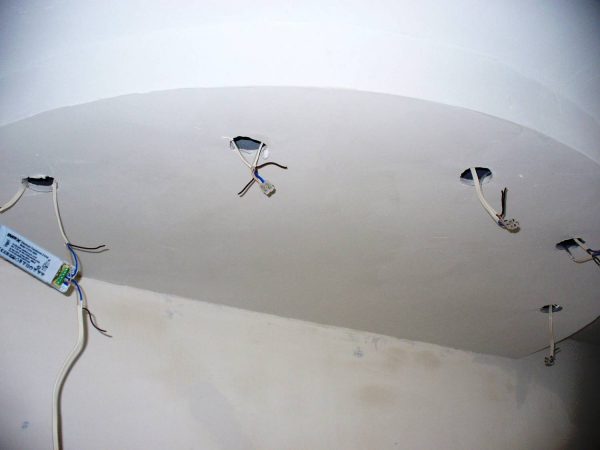 Finished holes in the false ceiling
Finished holes in the false ceiling Connection
The hinges are removed after drilling the required openings. Or the cable is laid from one opening to another, starting from the conductive one, leaving two cables. Work should be started after a complete blackout.
The wire is cut along the bend of the loop, and exposed by 15 mm. One end of the leads is clamped with a clamp, and the other is tightly fixed with a power cable. Factory marking of elements will help to keep the connection.
The following video will help you understand the DIY installation process in more detail.
Most built-in elements are equipped with two fasteners, presented in the form of brackets. The element is inserted into the ceiling by bending the bracket to the stop.
Be careful not to get caught in the cable. Once the lamp is in place, it is securely fixed to the surface with brackets. Connect the power cable to the distribution box and the switch only after the installation phase has been completed. Then check the work done.
In contact with
Suitable for decorating any room. Before installing the structure, it is imperative to select suitable lighting. In the suspended canvas, you can insert special recessed light sources, chandeliers or lamps attached directly to the profile. The installation of each of these structures has its own characteristics.
Connecting spotlights in a suspended ceiling: diagram and step-by-step instructions

The wiring diagram for recessed spotlights is quite simple. You can install these lighting devices with your own hands.
During the selection of materials and schemes for installation spotlights Please note that the length of the wires between the lamp and the current transformer should not exceed 2 meters.
- First you need to lay the wiring.
- Then mark up the ceiling.
- Use a drill to make a hole in the canvas. If the built-in lamp will have a square configuration, use a jigsaw.
- Pull the cable through the gap you made. Do not forget that it must first be de-energized.
- Pull the cable out.
- After that, connect the lamp to the cable.
- Fix installed lamp in the hole. To do this, use the spring clamps, which are located directly on the body of the lighting fixture.
- Then you need to insert a light bulb into the lamp.
- Put a decorative ring on the finished design.
Varieties of lamps for suspended ceilings
You can create a stunning and unique interior in your home or office using various lighting design techniques using recessed luminaires for suspended ceilings. They have become a real trend of our time due to the rich variety of colors, shapes, materials of manufacture, as well as the possibility of creating spectacular lighting projects. If you need to bring dynamics and freshness to the interior or just change something in better side, lamps on a false ceiling will easily solve the problem.
Types of recessed luminaires for false ceilings
During construction, recessed luminaires are mounted in the frame of the ceiling structure, and therefore they do not have specific fasteners. Whereas, for example, surface-mounted luminaires are installed after the installation of the ceiling is completed and are sometimes equipped with complex fixation mechanisms.
Ceiling lamps are of the following types:
- lamps fluorescent for suspended ceilings - very popular among those buyers who prefer energy-saving lighting systems;
- raster– ideal for public spaces;
- invoices with a double, mirror or parabolic grille - used in rooms with low ceilings in which the construction of a false ceiling with built-in lighting is not possible;

Ceiling lamp Grilyato
- Grilyato- outwardly similar to raster lamps, but have a different housing design; the installation of such lighting fixtures is easier and these are the most suitable Armstrong suspended ceiling fixtures;
- rack type e.g. brand name Lumsvet- perfectly complement the rack ceilings and can be installed both in residential premises and in offices and enterprises;
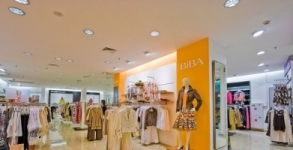
Ceiling with recessed downlights
- directional light fixtures or DownLight (DownLight) - have a mirror surface that reflects the luminous flux;
- dustproof lamp built-in for suspended ceilings - designed to operate in harsh operating conditions; installed in rooms where work is carried out with aggressive environments, high humidity or air temperature (for example, in bakeries, laboratories, industrial workshops, etc.); differs by IP classes (IngressProtection);

Recessed luminaires Ringo
- Ringo- provide accent lighting and are widely used in combined lighting schemes; are built-in, suspended and wall-mounted;
- point- illuminate the premises of small areas, the interior space of dressing rooms and cabinets, can perform a decorative function.
LED lamps Armstrong
False ceiling LED lamps have good technical specifications, durable and unpretentious in operation. In this regard, they can be successfully used for lighting residential, industrial, factory, household and industrial premises, streets and airports. They create comfortable lighting without flickering, close to natural. There is no ultraviolet component in the light beam.
Of particular interest are recessed fixtures for suspended ceilings such as Armstrong. They can illuminate large areas (shopping floors, large offices, etc.) and are an excellent alternative to raster lamps.
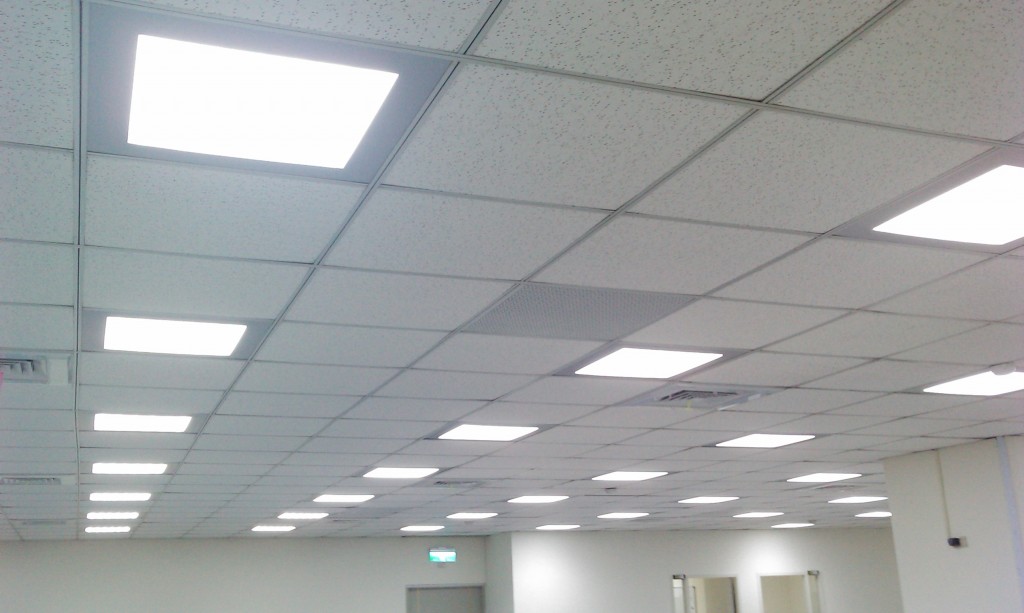
Armstrong ceilings with built-in lights
Benefits of Armstrong Ceiling Lights
Armstrong lamps have many positive characteristics:
- they consist of 32 Refond LEDs, which are evenly distributed over the entire area of the luminaire (600 x 600 mm);
- the LEDs are protected by an anti-vandal prism diffuser made of polycarbonate;
- light sources are mounted on an aluminum board, which contributes to excellent heat dissipation when they are heated;
- the service life of LEDs reaches 50 thousand hours of continuous operation;
- the device of fixtures based on a zener diode prevents their breakage if connected to a current source with adjustable polarity;
- during operation there are no electromagnetic interference;
- lamps work silently;
- compared with luminescent sources light, Armstrong lamps do not contain mercury and other hazardous substances and, therefore, do not require any special disposal conditions;
- Armstrong suspended ceiling luminaire produces an efficient luminous flux that is used to the maximum;
- Unlike fluorescent lamps energy consumption during operation is 2-2.5 times less, and compared to halogen - 10 times less.
Installation of lamps from LED modules
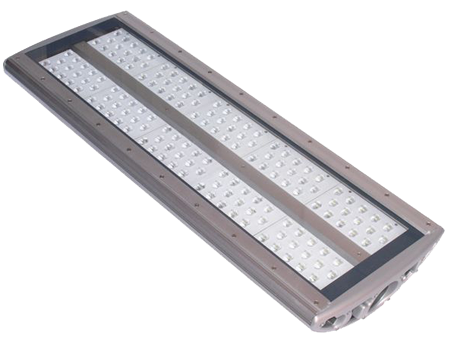
LED lamp
How the lamp is installed in a false ceiling, we will describe further. We also recommend that you watch a separate video material on how to install a lamp of one type or another in a suspended ceiling.
- On the body of the lamp, the markings are made of the places where the power supply will be fixed and. A ruler is applied to the body, marks are made, the required number of holes are made on them using a drill, into which self-tapping screws will be installed. If fastening is carried out with an adhesive method, holes do not need to be made.
- The self-tapping screws are twisted in such a way that the LED ruler is pressed tightly against the lamp body. When applying glue, glue is applied to the wrong side of the LED strip in 3-5 places, the parts to be joined are pressed and held pressed for about 3 minutes.
- Holes are drilled in the light source housing to fix the power supply, after which it is connected to the LED strips through the terminal block with the obligatory observance of polarity. Further, the unit can be mounted on the housing wall using nuts and bolts.
- The control of the correct connection of all elements and the connection of the power supply with the rulers is carried out.
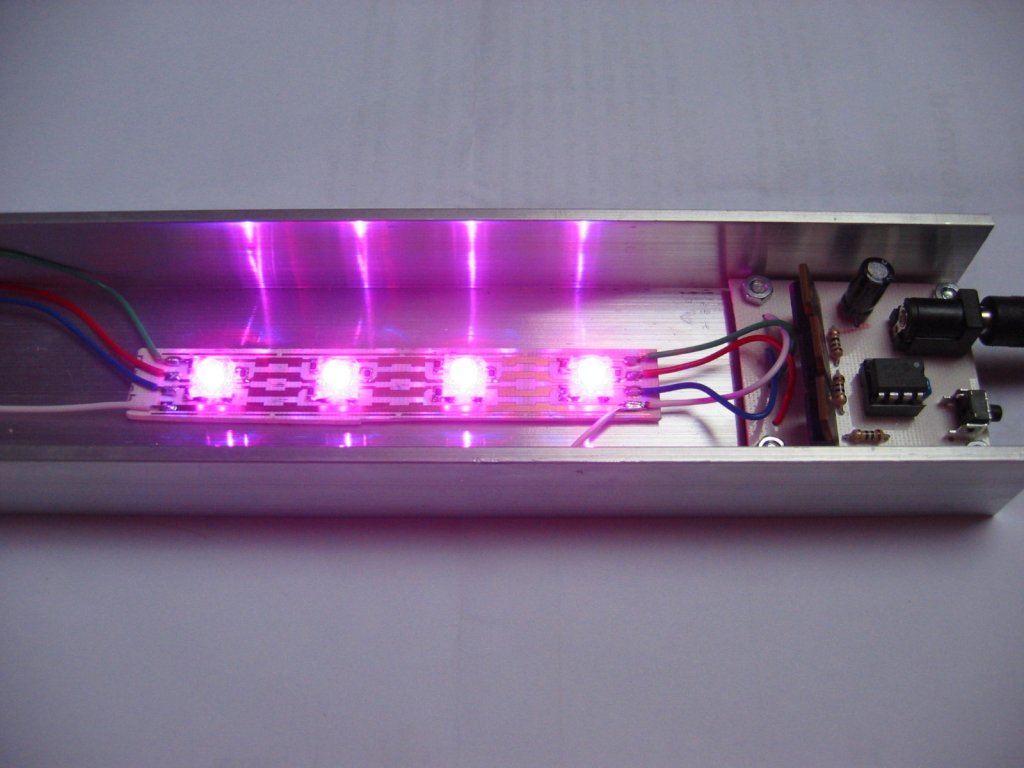
LED lamp device
- A reflector (diffuser) is installed on the luminaire body.
- The first inclusion of the assembled lamp is made.
- Recessed ceiling luminaire is installed in the ceiling structure.
Advice! When mounting modular luminaires, fasten the LED strip to the body of the lighting device with self-tapping screws using polyethylene washers. This ensures a tight fit between the parts to be joined.
Spotlights
Luminaires built-in for suspended ceilings are divided into spot and modular. Each type has its pros and cons and is used in various fields.
Another name for spotlights is focal, as they focus light radiation on a certain area of the surface, as if highlighting it. Such a luminaire for suspended ceilings, with the correct location and a sufficient number of light sources, allows you to efficiently and effectively organize the lighting of any room.

An example of general lighting with recessed spotlights
For example, if you want to create diffused lighting in a room, spotlights are placed around the entire perimeter of the ceiling, directing their radiation up to the ceiling. The white surface reflects the flow of light, evenly distributing it throughout the room and forming a cold, diffused lighting.
When the opposite effect of brightness in the room is needed, the luminaires are directed with radiation downwards. When using rotary lamps, it becomes possible to change the direction of the light beams.
As a rule, the control of spotlights is organized in groups: a switch for each group that illuminates different areas of the room. So, by pressing a button, you can create subdued lighting of a separate zone or, conversely, bright lighting of the entire room.
Spotlights are very diverse in design and are available in several types, so they are most popular in residential lighting, where aesthetic characteristics and comfort take the lead.

Types of recessed spotlights
Modular luminaires
Modular panels are used to illuminate public and office spaces. LED lights for false ceiling. Modular lighting fixtures are functional, ergonomic and safe to use, so it is advisable to use them in lighting shopping malls, showrooms, shops, banks, educational institutions, hotels, etc.
The design of modular luminaires is a complete, integral module, consisting of:
- lamps;
- protective housing with metal or plastic cover.
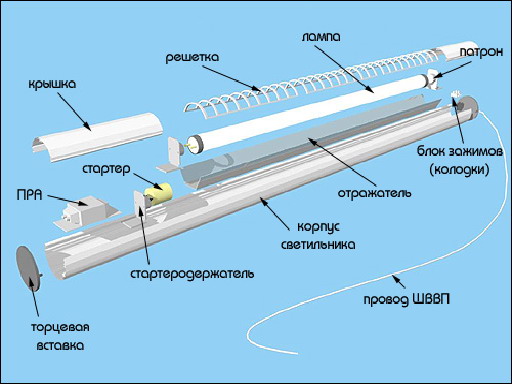
Scheme of the device of a typical modular lamp
Mounting of the modules is simple and can be done in rack or cassette suspended ceiling systems. Repair of the lamp does not cause difficulties, since if one module breaks down, it quickly changes to another, and if the lighting element in the module fails, it can be easily replaced.
Modular LED luminaires for suspended ceilings emit a direct beam of light directed downwards. For uniform distribution of the light flux over the entire area of the room, the modules are arranged in rows or in a checkerboard pattern. These fixtures are not presented in such a wide range as spotlights. Manufacturers make them either square or rectangular, but with different gratings and from different raw materials.
Advice! The fact that manufacturers produce only square and rectangular modular luminaires can also be considered an advantage: there is no need for a long search for a suitable module in case of breakage of a part of the luminaire.
Installation of raster recessed lighting fixtures in a suspended ceiling
We examined the features of recessed fixtures of this type, it remains to figure out what
- A suspended ceiling system is often a modular structure based on metal frame.
- The frame is attached to the ceiling, and modular elements are made of plastic, aluminum or drywall and can be panel, rack, cassette or tile.

Installation of the Armstrong ceiling and fixtures in it
- Installation of fixtures in a suspended ceiling takes place in free space(free cells for slabs), which is formed during the installation of the ceiling structure.
- Before fixing the lamp in false ceilings, bases should be built on the ceilings, to which all communications will be connected.
- Fixing fixtures on the ceiling and installing modules should be preceded by drawing up a diagram of their location.
- LED lamps in the false ceiling are fixed after the installation of those lamps that are located near the base.
Armstrong suspended ceilings are installed in most office buildings, business centers and other public spaces. And this is not an accident, because they are reliable, practical, beautiful and durable. It is obvious that for lighting buildings where such suspended ceiling structures are erected, it is optimal to use special lamps for Armstrong suspended ceilings.
Most often, spotlights are installed on. This design is universal. In some cases, it is more appropriate to install LED lighting or a chandelier. It all depends on individual preferences and the design of the room. Incandescent lamps are used as lighting fixtures for lamps or ice lights, halogen lamps or energy saving light bulbs. In most cases, LED spotlights are used, because they are universal.
Built-in luminaires for suspended ceilings: varieties and features
What lamps to choose with a limited budget? In this case, a built-in lamp will come to your aid. Built-in light sources are universal. They can be installed on both the bathroom and the living room. Built-in lamps are divided into several types.
There are 5 types of built-in lamps:
- Fluorescent lamps. This lighting option is the simplest and cheapest. In addition, fluorescent lamps consume little energy.
- Raster. Usually they are used for finishing ceilings in public places.
- Overhead. They can have a mirror or parabolic lattice. If the height of the room is small, then it is recommended to opt for overhead lights.
- Luminaires rack type.
- Directional lamps.
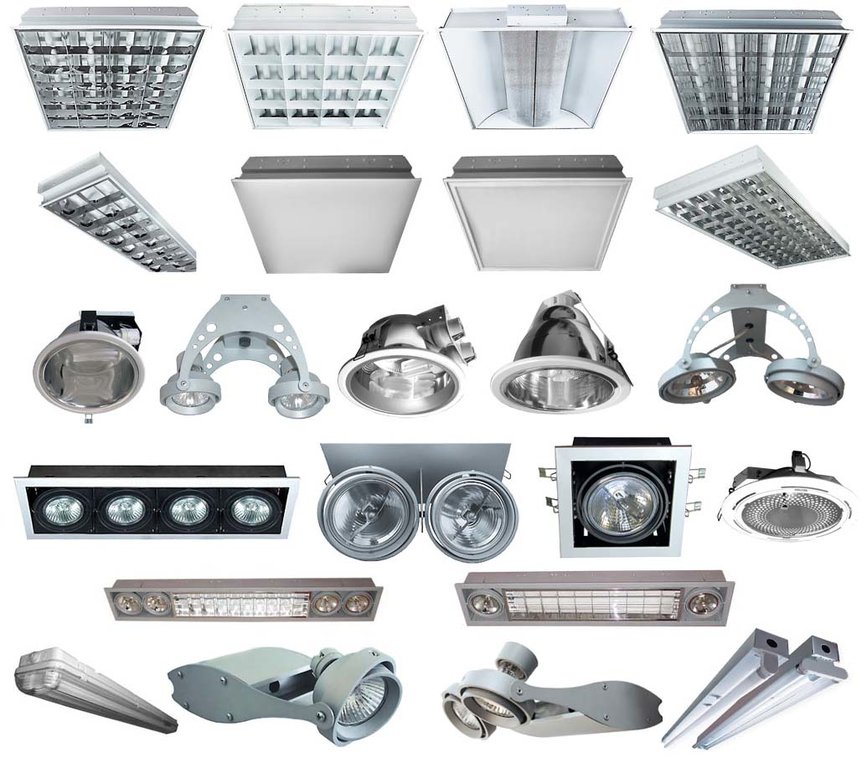
The built-in lamps also include Ringo lighting fixtures. They are used only if a combined lighting scheme is used. Ringo lamps are both built-in and wall-mounted.
Choosing spotlights for suspended modern ceilings
Point ceiling lights are the most common. They are installed on the frame after the installation of the suspended canvas on the base ceiling.
There are 3 types of spotlights:
- LED. Such a lamp is considered the best, because it evenly distributes light around the entire perimeter of the room. In addition, LED light sources are durable and consume little power. These lamps are recommended to be installed on high ceilings. LED lighting is made from LED light bulbs. Luminous tapes are attached to the profile.
- Lamps with halogen bulbs. Them distinguishing feature – high level light output. Halogen lamps emit a lot of heat during operation, so they are not recommended to be installed on PVC panels.
- Lighting fixtures with incandescent lamps. Such light sources are cheap, however, they serve very little.
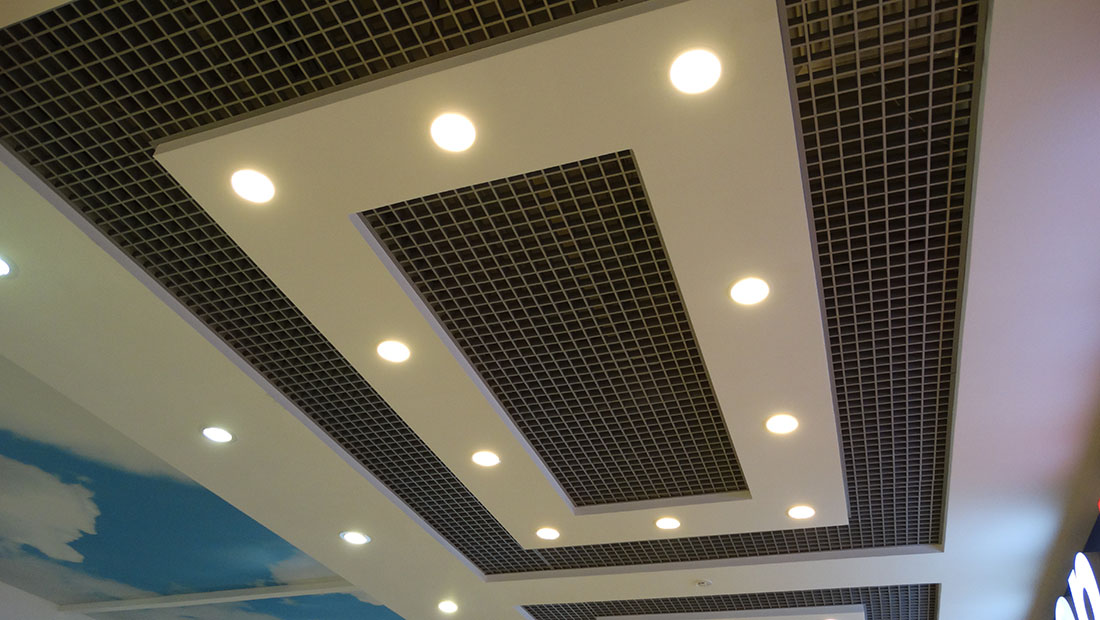
If you decide to use halogen bulbs, then take into account that they can have a power of 12-220 volts. If you decide to use low-voltage light sources, then remember that you should definitely install an additional transformer.
Like many years ago, it still remains the main element of lighting. At the same time, the fact that fashionable and practical suspended ceilings are used in the interior of the house will not be an exception. About which chandeliers are best to choose for this device, and how to attach chandeliers for suspended ceilings, will be discussed in this article.
How to choose a chandelier for suspended ceilings
Currently, the choice of chandeliers is truly huge. However, there are certain secrets of how to choose a chandelier for false ceilings. In the beginning, nevertheless, let's say that there are a number of modern misconceptions about which lamps are best suited to such "upper" designs. For example, it is believed that suspended ceilings and chandeliers are not compatible: they say, it is better to give preference to spotlights and modular recessed lights. But it's not. The modern range of false ceilings today is so wide and varied that many of its forms are perfectly combined with chandeliers, and not just with small decorative lighting fixtures. Moreover, now many manufacturers produce chandeliers specially designed for suspended ceilings. As a rule, such models have a more modern, innovative design, consist of a bunch of small hanging shades, and also have a lighter design.
But if you decide to purchase chandeliers for suspended ceilings that do not have such a special purpose, then we advise you to pay attention to the following recommendations. So, you need to avoid buying "dish" type chandeliers, especially those made of thin metal. This is due to the fact that during operation the body of the product will become very hot and dark spots may appear on the ceiling.
This also fully applies to other design features of chandeliers for suspended ceilings. Their lamp must be inside the ceiling, and when choosing chandeliers with open lamps, preference should be given to models with light sources pointing down or to the side. Otherwise, again, you cannot avoid ugly sings on the ceiling.
How to hang a chandelier on a false ceiling
If you want to hang a chandelier on a false ceiling, then most likely one of the four possible options will suit you. All of them are designed to beautifully and securely place chandeliers on the ceiling that have different "weight categories": from a light modern model to
The first method involves attaching a chandelier to a false ceiling. This method is good to use if the lamp has a weight of up to 5 kilograms. Then the chandelier can be safely attached to a suspended ceiling made of plasterboard or MDF panels. But not on Armstrong suspended ceilings, as mineral-fiber boards and this weight of the structures will not be able to withstand. In general, with this method, you can use plastic or metal dowels. But it is also important to ensure that the ceiling does not bend or collapse under the weight.
The second method of attaching chandeliers for false ceilings is to attach them to the old ceiling through the new one. This method is the most reliable. To implement it, a hole is carefully drilled in the suspended ceiling, through which the main hook is inserted, brought out by one or two adapters. At the same time, overcoming the desired height from the old ceiling to the new one can be done without adapters (distance up to 15 centimeters) or with adapters (distance more than 15 centimeters).
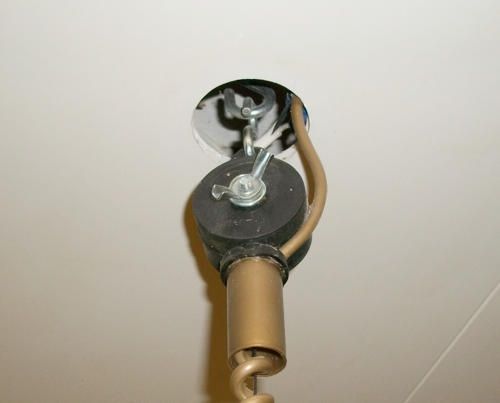
The third way to place a chandelier for suspended ceilings is to create a frame for the lamp. This method used when the distance between the old and false ceiling is large enough. To create an additional frame for the lamp, a small hole is drilled in the suspended ceiling, into which a wooden bar or metal profile is inserted, which, in turn, is screwed to the old ceiling. This method is considered the most difficult and time consuming, however, with it, you can hang chandeliers of a sufficiently large weight and use a room in which there is initially no hook for a chandelier.





